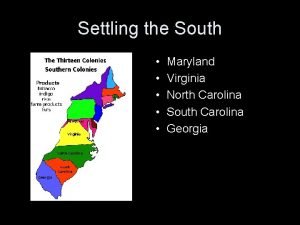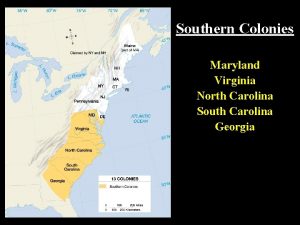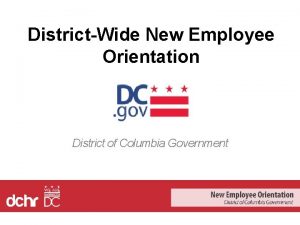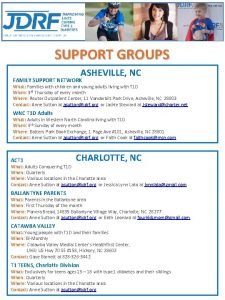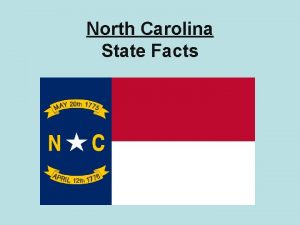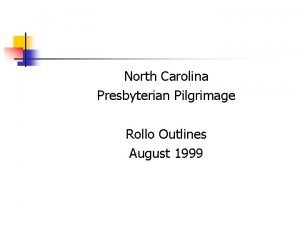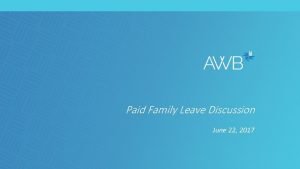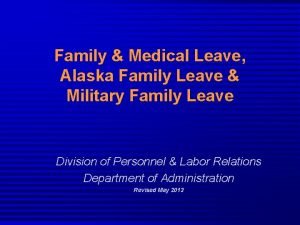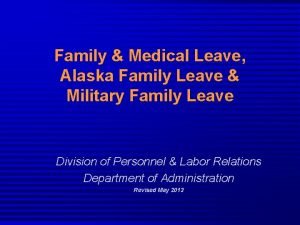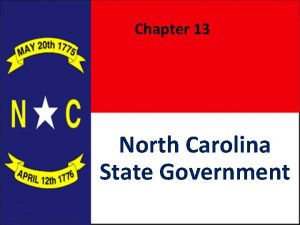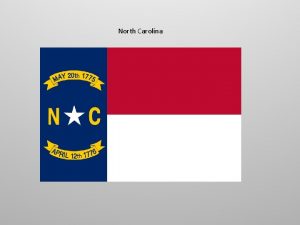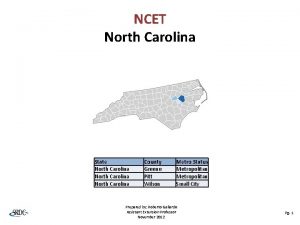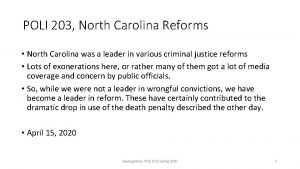Paid Family Leave in North Carolina An Analysis















- Slides: 15

Paid Family Leave in North Carolina An Analysis of Costs and Benefits Presented by: Anna Gassman-Pines, Ph. D WLF Bass Connections Associate Professor of Public Policy and Psychology and Neuroscience December 2, 2019

Origins of this Study

Paid Family and Medical Leave Insurance (PFLI) ● PFLI is a specific type of paid family leave that is publicly provided and operates statewide ● In PFLI programs, employees pay an insurance premium into a fund from which they can draw for qualified leave purposes

Snapshot of Key Findings ● ● ● PFLI increases labor force participation and employee retention. PFLI improves the health of mothers and infants. Viewed by businesses as having had a positive or no noticeable effect. Potential cost savings from estimated impacts outweigh administrative costs. Decreases infant mortality and nursing home usage.

Existing Leave Programs ● 1993 Family Medical Leave Act (FMLA) ○ 12 weeks unpaid, job-protected leave ○ Covered employers: those with 50+ employees ○ Eligible employees ○ Worked for covered employer for 12+ months ○ Worked at least 1, 250 hours in prior year ○ Works at a location with 50+ employees within 75 miles ○ Leaves for new child, care of ill family member, own illness

Existing Leave Programs Eight states and DC have adopted Paid Family Leave Insurance (PFLI) o o o o o California (2004) New Jersey (2009) Rhode Island (2014) New York (2018) Washington (2020) DC (2020) Massachusetts (2021) Connecticut (2022) Oregon (2023)

Components of a Statewide Paid Leave Policy ● ● ● ● Employee contribution Eligibility Covered events Duration of leave Wage replacement = pay while on leave Cap on benefits Waiting period Take-up rate Importance: These variables influence cost and benefits

Simulating Two PFLI Proposals for NC Proposal A Proposal B Maximum Duration of Leave 8 weeks 12 weeks Amount of Benefit 55% of wages up to weekly max 80% of wages up to weekly max Maximum Weekly Benefit $486 $875 Wage Base for Premium Up to $25, 292 Up to $45, 526 Waiting Period One week No waiting period Eligibility ● ● Worked at least 80 hours in the last year At least $1, 560 total earnings in last year

Two Simulation Methods Model 1 Modifies a model created by the Montana Budget and Policy Center in 2015 Model 2 Uses the Albelda Clayton-Matthews/ IWPR 2017 Simulator Model (University of Massachusetts-Boston)

Estimated Participation Proposal A Proposal B Model 1 Model 2 4. 7 m 4. 8 m Number of covered employees taking PFLI leave per year 193, 389 229, 483 193, 389 277, 744 Average weekly PFLI benefits paid to employees taking PFLI leave $335 $330 $537 $520 Total amount of PFLI benefits paid to all PFLI leave takers PY $360 m $497 m $865 m $1, 157 m Covered employees per year

Estimated Costs Proposal A Proposal B Model 1 Model 2 Employee premium as a % of earnings per year 0. 35% 0. 54% 0. 58% 0. 89% Average weekly premium cost per worker $1. 47 $1. 97 $3. 52 $4. 59

Impact on Infant Mortality 26 infant lives in North Carolina would be saved per year under a PFLI proposal that simulates a statewide 12 -week paid leave policy with 80% wage replacement. Saving 26 infant lives would reduce the North Carolina infant mortality rate to 7. 1 per 1, 000 from 7. 3 per 1, 000.

Impact on Infant Low Birth Weight Our simulations show that a statewide 12 -week PFLI policy with 80% wage replacement would reduce the number of infants born low birth weight by 776 infants. Because low-birthweight infants require more medical care than infant born at normal birthweight, between $2 million and $11. 7 million would be saved.

Other impacts on Families and Workers ➔ Reduced nursing home usage ➔ Reduced use of government assistance ➔ Improved workforce and health outcomes ➔ No evidence of negative impact on employers

Thank you! Collaborators: ● Elizabeth Ananat, Ph. D. , Barnard College ● Hadeel Abdelhy, BA ● Mary Edgerton, MPP ● Kristen Jensen, MPP ● Josie Link, MPP ● Pooja Rao, MPP ● Melissa Roark, MPP ● Eliza Salmon, MPP ● Sarah Vanderbilt, MPP Anna Gassman-Pines, Ph. D. agassman. pines@duke. edu (919) 613 -7301 Full study link: Duke paid leave study
 Georgia, south carolina, north carolina, virginia, maryland
Georgia, south carolina, north carolina, virginia, maryland Map of north carolina and south carolina
Map of north carolina and south carolina Maryland, virginia, north carolina, south carolina, georgia
Maryland, virginia, north carolina, south carolina, georgia Virginia, maryland, north carolina, south carolina, georgia
Virginia, maryland, north carolina, south carolina, georgia Dchr paid family leave
Dchr paid family leave Family support network of north carolina
Family support network of north carolina North carolina sunshine laws
North carolina sunshine laws North carolina's state motto
North carolina's state motto North carolina victim assistance network
North carolina victim assistance network Callie zipple
Callie zipple North carolina state motto
North carolina state motto North carolina presbyterian pilgrimage
North carolina presbyterian pilgrimage North carolina state fruit
North carolina state fruit Nchsaa wrestling regionals
Nchsaa wrestling regionals North carolina landmarks
North carolina landmarks Ugly jugs history
Ugly jugs history


